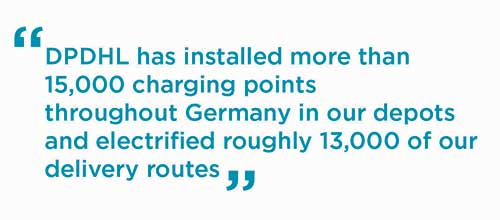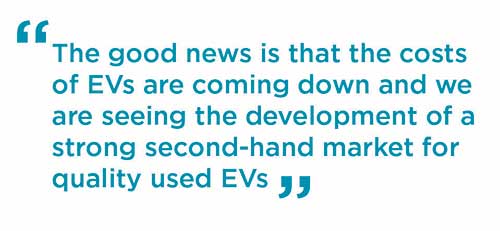The automotive industry has been dominated by a few specific topics in the last year; from coronavirus (COVID-19) to electromobility and the advance of new technologies. But how have these subjects impacted one of the most important automotive sectors? In a new series, Autovista Group’s Daily Brief journalist, Tom Geggus, speaks with industry insiders to discover how these themes are changing fleets. In this third instalment: technology.
COVID-19 has impacted fleets, electromobility is changing fleets, but how will technology shape the future of fleets? From long-awaited self-driving capabilities to the potential for data-driven vehicle management, there exists a smorgasbord of technological advancements for fleets. But if necessity truly is the mother of invention, then fresh approaches to electrically-chargeable vehicle (EV) infrastructure would satisfy an industry-wide appetite. As Chinese OEMs look to the European market, this may be a hunger they could satisfy.
Game-changing services
Even before COVID-19, Chinese OEMs were ready to join the European market. ‘They have the supply; they have the vehicles. So, they are really eager and ready to offer their product and meet the growing demand for EVs,’ explained Mathijs van der Goot, global lead on electric vehicles for LeasePlan. These new entrants look to Europe as a priority. So, it might not be long before alternative ownership concepts, different distribution systems and new technologies create new dynamics in the market.

For example, Chinese OEMs could bring with them a new approach to vehicle supply and distribution. ‘They want to move faster. Asking questions like; do we really need that, can we do it differently, can we do it smarter? And each of them does it a little differently. But you see extremely interesting supply chains being created by how they look at their business – it is exciting for the whole market.’
One Chinese OEM is approaching the issue of EV charging differently. Nio recently launched Battery-as-a-Service, where subscribers can swap out and even upgrade their batteries as needed. ‘So, you drive into a garage, and they swap the battery at once, and you can continue. There is no need to plug it in,’ said Van der Goot. With no wall-box installation necessary and no electricity bills to be submitted, a service like this could transform the way fleets manage EVs and their infrastructure.
However, this does not look to be the only service with the potential to disrupt the world of fleets. Alain Duez, co-founder of management consulting company, let it fleet, highlighted the market absence of a multi-model mobility management application. This would serve as a universally applicable system, capable of managing a range of different services, from a car to an electric scooter and even public transport.
‘A real application that could help to integrate all these aspects in an e-system will be key, and it does not exist on the market yet,’ he explained. Duez went also outlined the potential for an app like this to exist within the next five to 10 years. The concept of Mobility as a Service (Maas) has been around for a while. Still, a system capable of supporting the continued demand for the company car, while also equipping fleets with every other transport option would be a game-changer.
The new oil
So, service-based innovations like these could alter how fleets operate, not to mention help end the drought of EV infrastructure. But the automotive industry has yet to plumb the depths of another one of its major technological resources. When explaining what could drive the future of fleets, Paul Hollick, chairman of the Association of Fleet Professionals (AFP), took a deep dive into data.
‘Data. Insight, through data. Not data for data’s sake. Data is the new oil,’ he said. ‘Data and the production of data into indices and metrics to be able to drive down efficiencies. Work out what the best powertrain is per-employee, based on where they live, where they work, their driving styles, their trips, and how many accidents they have,’ Paul said.
But he explained that this information must be utilised properly to provide insights to that can drive change, rather than just generating lists which serve no true purpose. ‘A fleet manager has never had so much opportunity to be able to get the data to be able to shape their strategies.’ This can then be used to reduce carbon, cost, and accident rates.
While telematics technology has continued to take leaps and bounds within the world of heavy goods vehicles (HGVs), there has been little news on the topic for passenger cars. Wim Buzzi, co-founder of let it fleet, highlighted how strange this is given the amount of data a car is now capable of generating, processing and potentially utilising. Successful deployment of data could fundamentally change how a car is managed.

‘Your car could schedule an appointment for maintenance, by first checking your calendar, if it fits with work, then sending a message to the dealership that they need to order parts A, B and C because that is what will need to be replaced,’ Buzzi said. ‘This means dealerships are not sitting with a whole warehouse full of parts, which is dead money.’
Technology like this does already exist Buzzi explained. By connecting smartphones with cars, events are scheduled, with information about routes and traffic jams made available and emails automatically sent to cover late arrivals.
The manufacturer can also benefit from the proper utilisation of data. Getting a better understanding of the life expectancy of a part, when it will need to be changed and how it could be upgraded. ‘So, we will avoid more damage, manufacturers will know how to upgrade their parts and improve their service,’ he said. ‘But for that we will need 5G, because we need the data to send all of this information. It is coming, and it will definitely affect how we approach mobility and fleet management.’ But all of this progress is dependent upon the foundation of fleets, which is the car, and this foundation has to be well managed first and foremost.
Putting safety first
Buzzi also sees the rollout of advanced driving assistance systems (ADAS) as playing a major role in the development of fleets. The advance of lower-level autonomous capabilities is making its way down the vehicle food chain. Buzzi pointed out that it is only a matter of time until these systems are seen in more affordable fleet cars.
The technology holds a huge potential to advance road safety. For example, Automated Lane-Keeping System (ALKS), takes over control of a vehicle at low speeds, keeping it in a lane, especially on dual-carriageways and motorways. This technology could help reduce fatigue for drivers on long stretches of roads, in theory reducing the rate of accidents.
‘[Autonomous technology] could make our roads safer,’ the UK’s secretary of state for transport Grant Shapps commented in August, as the UK began seeking evidence to shape autonomous legislation. ‘In 2018, 85% of road collisions in the UK that resulted in injury involved human error. Automated vehicles could reduce these errors as they will not get tired or distracted. Other countries around Europe are also committing to self-driving technology. The German government is reportedly consulting on a €2 billion automotive aid package, part of which looks to back the advancement of autonomous capabilities.
OEMs are investing heavily in these capabilities as well. Daimler Trucks has partnered with Waymo to develop SAE Level 4 trucks, as they both look to further road safety and efficiency for fleet customers. The autonomous Freightliner Cascadia truck will be available to customers in the US in the coming years, with the partnership investigating potential expansion to other markets and brands in the near future.
‘The combination of increased road freight volumes and the need and vision of fleet operators for highly automated trucks, is what fuels our relentless pursuit of innovation,’ said Roger Nielsen, member of the board of management of Daimler Truck AG. ‘We are pushing engineering solutions that strive above all to increase safety and help our customers improve business efficiencies. Based on our collaboration with Waymo, we will be in the unique position to be able to provide our fleet customers with a choice among the best solutions for their individual requirements.’
DHL’s trend radar shows that while self-driving vehicles are categorised as having a potentially high impact on logistics, this may not be a relevant influence for another five to 10 years because of legal, technical and social barriers.
DHL’s Logistics Trend Radar

Source: DHL
So, autonomous technologies contain the potential for safer roads, decreasing fleet costs and inefficiencies. But with legislation and technology still taking shape, it may be some time before fully self-driving cars are chauffeuring staff members to meetings, while autonomous commercial vehicles make deliveries. While lower-level autonomous support systems make fleets safer in the interim, other automotive technologies like data analysis and mobility services can help shape the future of fleets.
Want to know how COVID-19 has impacted fleets? Catch up with the first fleets series instalment here. Interested in how electromobility is changing fleets? Read the second article here. Still hungry for more insights? Then stay tuned for a special fleet focused podcast coming next week, featuring Autovista Group’s chief economist Christof Engelskirchen.

 Schließen
Schließen







